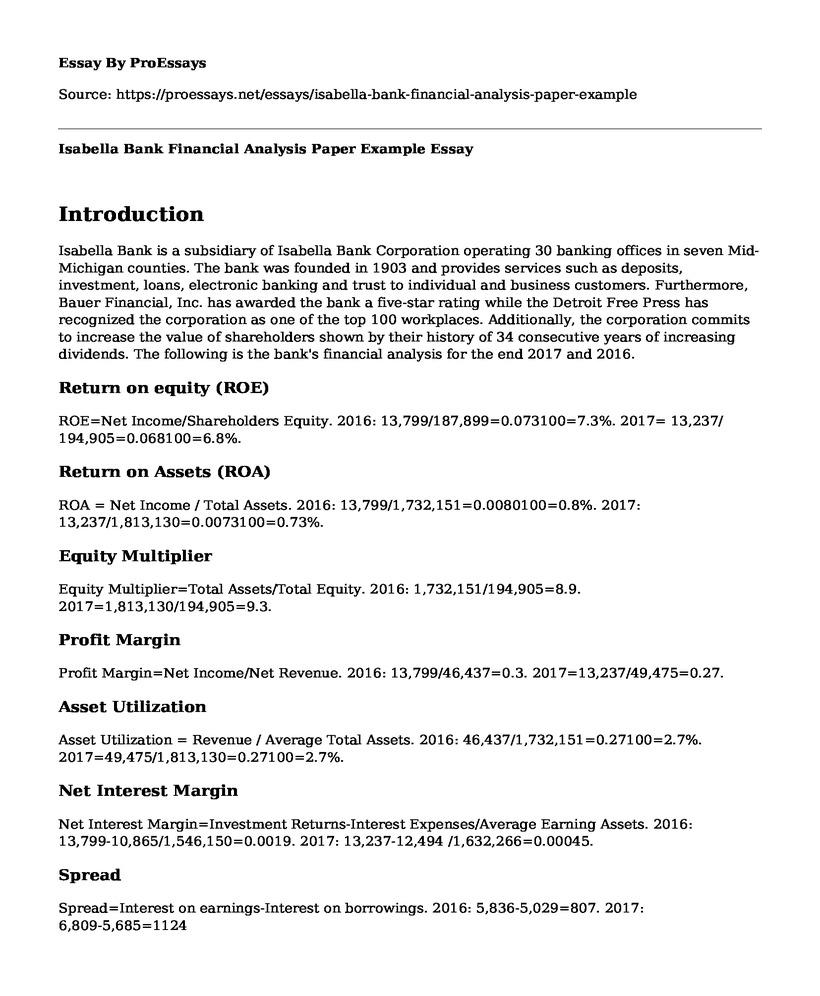Introduction
Isabella Bank is a subsidiary of Isabella Bank Corporation operating 30 banking offices in seven Mid-Michigan counties. The bank was founded in 1903 and provides services such as deposits, investment, loans, electronic banking and trust to individual and business customers. Furthermore, Bauer Financial, Inc. has awarded the bank a five-star rating while the Detroit Free Press has recognized the corporation as one of the top 100 workplaces. Additionally, the corporation commits to increase the value of shareholders shown by their history of 34 consecutive years of increasing dividends. The following is the bank's financial analysis for the end 2017 and 2016.
Return on equity (ROE)
ROE=Net Income/Shareholders Equity. 2016: 13,799/187,899=0.073100=7.3%. 2017= 13,237/ 194,905=0.068100=6.8%.
Return on Assets (ROA)
ROA = Net Income / Total Assets. 2016: 13,799/1,732,151=0.0080100=0.8%. 2017: 13,237/1,813,130=0.0073100=0.73%.
Equity Multiplier
Equity Multiplier=Total Assets/Total Equity. 2016: 1,732,151/194,905=8.9. 2017=1,813,130/194,905=9.3.
Profit Margin
Profit Margin=Net Income/Net Revenue. 2016: 13,799/46,437=0.3. 2017=13,237/49,475=0.27.
Asset Utilization
Asset Utilization = Revenue / Average Total Assets. 2016: 46,437/1,732,151=0.27100=2.7%. 2017=49,475/1,813,130=0.27100=2.7%.
Net Interest Margin
Net Interest Margin=Investment Returns-Interest Expenses/Average Earning Assets. 2016: 13,799-10,865/1,546,150=0.0019. 2017: 13,237-12,494 /1,632,266=0.00045.
Spread
Spread=Interest on earnings-Interest on borrowings. 2016: 5,836-5,029=807. 2017: 6,809-5,685=1124
Overhead Efficiency
Overhead Efficiency=Total Expenses/Total Revenue. 2016: 46,437/37,897=1.23. 2017: 40,225/49,475=0.81.
ROE is an excellent measure to estimate the future growth in dividends as well as stock growth, and for Isabela Bank, the measure indicates a healthy financial future. ROA indicates the profitability of the company about the available assets. The calculated values, therefore, indicate that the bank is putting its assets into good use to generate revenue. Equity multiplier is a ratio used to determine a company's financial leverage. A high ratio means that the bank uses more debt than equities to finance its operation which is not the case with Isabela Bank. On the other hand, the profit margin is the margin by which the revenues resulting from sales exceeds the cost incurred by the business to attain those revenues. Therefore, it is a good profitability ratio used to gauge how profitable the business activities are, and since it is positive for the bank, it indicates financial health.
Asset utilization determines the total revenue earned from each dollar of a company's assets. An increasing value of asset utilization ratio entails that the company is efficient in using its assets to generate revenue like is the case with the bank. Net Interest Margin is a measure of the difference between interest income that banks and other financial institutions generate and the amount that they pay out to their lenders respective to the amount of assets. Therefore, it is equivalent to the gross margin of non-financial companies. Spread refers to the difference in lending and borrowing rates in financial institutions. The rate is determined by subtracting interest rates on borrowing from the interest yielded from earning assets such as loans. The spread for the bank increases from 807 to 1124 which is a good indicator of financial health.
The efficiency ratio measures a bank's overhead as a percentage of the total revenue. When the efficiency ratio of a bank is on the rise, it means that its expenses are increasing or its revenue is decreasing. An efficiency ratio is, therefore, a good measure of the ability of the bank to use its assets effectively. The overhead efficiency ratio for Isabela Bank is on the decline indicating that revenues are increasing as compared to expenses. The bank's CAMEL evaluation is a ratio based tool to rate the performance of a bank in which a bank is expected to enhance capital adequacy, improve management, strengthen asset quality, reduce susceptibility to risks and improve liquidity. From the calculated values, it is apparent that the bank is improving in all these vital aspects of the business. Net income in 2016 was 13,799 while in 2017 it was 13,237 indicating a slight decrease which could be as a result of defaulted loans or increasing expenses. In 2016, the provision for loan losses was negative 135 while in 2017 it was 253 which is a great improvement to cushion the bank. Total deposits in 2016 were 1,195,040 while in 2017 it was 1,265,258 which is a difference of 70218 indicating massive improvement.
Cite this page
Isabella Bank Financial Analysis Paper Example. (2022, Sep 22). Retrieved from https://proessays.net/essays/isabella-bank-financial-analysis-paper-example
If you are the original author of this essay and no longer wish to have it published on the ProEssays website, please click below to request its removal:
- Paper Example on Methods of Accounting
- Accounting Fraud at WolrdCom Case Study Paper Example
- Paper Example on PNC: Comprehensive Banking Services for Individuals & Corporations
- Unlocking the Potential of Technology Scanning: A Strategic Investment for Business - Essay sample
- Essay Example on Government Health Insurance Programs: Coverage & Eligibility
- Free Research Paper Sample on Funding for Health Department
- Paper on Project Control and Cost Analysis







